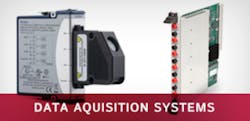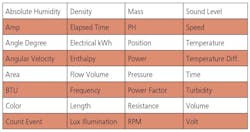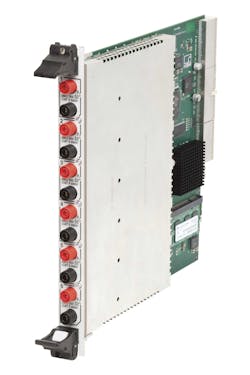What types of variables do DAQ systems need to accommodate? You can get an idea of the kinds of quantities that are commonly measured by reviewing Echelon’s LonWorks list of 166 standard network variable types (SNVTs). LonWorks networks often are used in HVAC and process-control applications, so areas like nuclear physics and aeronautics may be under-represented. Nevertheless, the SNVT list isn’t a bad place to start.
Predefined SNVTs simplify exchange of information among LonWorks network nodes. For example, SNVT 147, temperature difference, describes a signed long 2-byte variable with a valid range from -327.68°C to +327.66°C with 0.01°C resolution. If a node specifies that SNVT 147 applies to the data it is sending, and a receiving node is configured to use the same SNVT, the receiving node automatically knows the range and resolution and that the Celsius scale is being used.
A large number of SNVTs are related to the status of a control or device, and several others deal with things like file structure, character strings, and register values. Of the remaining 32 basic physical phenomena shown in Table 1, only amps, volts, electrical energy (kWh), power, power factor, and resistance are inherently electrical while the other 26 require a sensor or transducer to become compatible with DAQ systems. The number 32 ignores multiple ranges that need more than one SNVT, for example volts and millivolts.
Courtesy of Echelon
Powered sensors, such as strain gages and load cells, receive excitation from the DAQ system, which also filters and amplifies their outputs and provides analog-to-digital conversion. Passive sensors such as accelerometers and thermocouples also may have special needs. For piezoelectric accelerometers, charge-to-voltage conversion is necessary, and thermocouples require linearization and cold-junction compensation (CJC).
For sensors with integrated transducer electronic data sheet (TEDS) capability, power is needed to activate the embedded EEPROM that holds calibration and/or compensation values. If the TEDS implementation is virtual, then the DAQ system design must be capable of accessing calibration/compensation values stored in the system memory, but TEDS-related power is not needed by the sensor.
Signal conditioning
The definition of signal conditioning is somewhat arbitrary, although the overall process often is partitioned as analog signal conditioning ahead of the ADC and digital signal processing after the ADC. Signal conditioning may occur in multiple stages and places. For example, some accelerometers integrate the charge-to-voltage converter so that part of the signal conditioning is done in the sensor. Separate external amplification and filtering also may be needed.
Sensor-specific
UEI’s Bob Judd, director of marketing, explained it this way, “One of the things we stress with our engineers is that we want our customers to be able to connect directly to our I/O modules without requiring any intermediate conditioners. [As an example] … we’ve released the DNx-DIO-449 digital input board that can monitor anything from 3.3-V logic levels to 125-VAC without any intermediate signal conditioning.” He concluded, “Historically, this flexibility would only be possible with a series of externally mounted solid-state I/O modules.”
In the example Judd gave, only digital and AC signals can be monitored, but the range of voltages is very large. UEI uses a similar approach in the 12-channel DNx-AI-222 RTD board and the 12-channel DNx-AI-212 thermocouple board. Both these boards offer comprehensive temperature measurement, but for one type of sensor. In Judd’s view, a module should provide complete signal conditioning for a certain application.
VTI Instruments’ Tom Sarfi, vice president of product management, explained how his company approached the issue. He said, “We will typically design our products to handle voltage and a specific transducer type which is most suitable for larger scale measurement systems, as we are able to optimize our designs for higher channel counts. EX1000A-TC can measure [thermocouples] … and voltages on each channel, and the EX1629 can handle strain and voltage on each channel.”
Sarfi continued, “We believe modular platforms offer the flexibility to cover a wide range of measurement capability in a small form factor for smaller channel count mixed-signal applications, and in this way, we are able to offer the best price/performance on a module-by-module basis. In other words, a single mainframe can house modules that are [each] designed to perform a specific function.”
Courtesy of HBM
HBM also has adopted a sensor-specific approach in the company’s Genesis DAQ signal conditioning cards, according to Bart Morrick, an applications engineer with the company. He discussed the GN610 1-kV card (Figure 1): “This card samples at a high 2-MS/s rate and can make direct 600-Vrms [measurements] that allow it to be uniquely qualified in all sorts of industrial applications. [It] meets … CAT II and CAT III isolation standards and has a wide input range from ±20 mV up to ±1,000 V. We have a customer doing various tests on the effects of high voltage on tissue—one channel is measuring the high-voltage shock in the 1-kV range, and the channel immediately next to it is measuring the response in millivolts on the muscle tissue without the high-voltage signal drowning out the low-level signal.”
Also related to high voltage, Saelig has introduced the CLIPPER CLP1500V15A1, which, according to Alan Lowne, company CEO, is a unique voltage-clipping device for measuring MOSFET performance. The datasheet states, “Making accurate measurements in the presence of very high voltages has previously been extremely challenging, but using the CLIPPER CLP1500V15A1, the VdsON or RdsON of a switching transistor can now be easily seen in high resolution (e.g., 100 mV/div) on an ordinary digital oscilloscope. Determining the switching speeds, safe operating area, and temperature effects of MOSFETs and IGBTs is now greatly simplified ….”
Two other HBM Genesis cards address more specialized applications. The 1-MS/s bridge card supports one-quarter, one-half, and full-bridge applications as well as string pots and PT100 RTDs. It has an isolated differential input and, because of the high sampling rate, addresses ballistic and other high-speed bridge-type sensor requirements. The second card, a 100-MS/s differential card, can be used in high-speed, low-noise testing. For example, it is suitable for the signals generated during impact testing with a Hopkinson Bar.
DATAQ Instruments’ Roger Lockhart, company vice president, said, “In our view, only isolated instruments should be deployed for field measurements. We don’t attempt to separate isolation from measurement function and range; it’s just as important.” The recently introduced DI-245 thermocouple and voltage DAQ system provides a choice of 12 voltage ranges from 10 mV to 50 V for each of four isolated channels. If instead, an input is programmed for a thermocouple, J, K, T, B, R, S, E, and N types are supported with linearization and accuracy to 0.1% or 0.2% of temperature span.
Courtesy of DATAQ Instruments
Isolation is important because a thermocouple may be directly attached to an off-ground voltage to measure the temperature of a high-current terminal. This adds a large common-mode voltage to the very small thermocouple signal. The USB-powered DI-245 (Figure 2) provides >100-dB CMR DC to 60 Hz, 330-Ω imbalance along with 120-Vrms isolation input-to-output and channel-to-channel.
One of the models in Omega Engineering’s DRSL range of DIN rail-mounted signal conditioners is the DRSL-RTD-ISO unit with an isolated two-, three-, or four-wire Pt100 RTD-input. It features capabilities such as shorted and broken sensor detection and selectable current or voltage output together with 0.1°C accuracy. In addition to this model, the range includes several other isolated and nonisolated signal conditioners in the same size housing.
The company’s Anthony Corvini, a DAQ engineer, explained that the small size of the DRSL module as well as its technical specifications facilitate application solutions. He said, “[A customer needed to] convert a large number of thermocouple inputs into voltage outputs to go to an existing DAQ system with limited space in the control cabinet. This was addressed by using the DRSL-TC thermocouple input signal conditioner, which has a slimline housing only 0.24-inch wide.”
Isolation is a critical part of operator and equipment safety precautions when making three-phase power measurements. David Ashlock, product marketing engineer for DAQ at National Instruments, said, “NI’s CompactDAQ and CompactRIO platforms integrate connectivity and signal conditioning into modular I/O to directly interface with any sensor or signal in a test and measurement application.” There are more than 50 types of C-Series I/O modules compatible with both platforms.
Ashlock continued, “Specifically, National Instruments has increased performance and voltage range for single and three-phase measurement configurations, such as WYE and delta with the NI 9242 (250 Vrms L-N, 400 Vrms L-L) and the NI 9244 (400 Vrms L-N, 800 Vrms L-L). These modules have a CAT III working voltage and can be designed into systems to meet numerous standards such as IEC 61010-1, C37.90 and C37.60, IEC 60255-22-(1:7), IEC 60255-1, C37.188 Class M and P, EMC section of IEC 60870, EMC sections of IEC 61850, IEC 61000-4-30 Class S, and IEC 61000-4-7.”
Courtesy of National Instruments
The CAT III-rated NI 9242 and NI 9244 (Figure 3) measure three phases to neutral and separately neutral to ground. The NI 9225 measures only the three-phase voltages and is rated CAT II. This means that the NI 9225 is limited to measuring local-level electrical distribution, such as that provided by a standard wall outlet. In contrast, CAT III modules can be used on hard-wired equipment in fixed installations, distribution boards, and circuit breakers. A CAT IV rating is necessary for instruments used to measure voltages where they originate from the utility company.
Keysight Technologies makes a large range of PXI/PXIe modules associated with DAQ applications—DMMs, switches, and digitizers. However, the USB-based U2300A multifunction DAQ module is more closely related to the signal conditioning theme. In particular, the U2802A 31-channel thermocouple input signal conditioner that is used with the DAQ module provides NIST-traceable calibration, voltage or thermocouple input mode selection, and CJC. Voltage inputs to 10 V are supported as well as type J, K, R, S, T, N, E, and B thermocouples.
Universal
An alternative approach provides a so-called universal input that accommodates several distinct types of sensors in a single module. A mainframe can house a number of identical modules but handle a wide variety of sensor types by programming each module accordingly.
As Hi-Techniques’ Gary Schneider, senior product manager, commented, “Once a good millivolt-level amplifier and digitizer are designed, there is relatively little overhead in adding signal-conditioning modes. A bridge amplifier requires adding a precision voltage source, completion, and shunt calibration resistors. A precision constant-current source and AC coupling are required to support an ICP-type sensor or current-fed strain gage.”
Hi-Techniques’ Synergy benchtop DAQ system features a universal signal-conditioning module that provides a DC bridge input with support for one-quarter, one-half, and full bridges; constant-current excitation for ICP accelerometers; charge converters for charge-mode transducers; direct thermocouple inputs; voltage inputs from 20 mV to 20 V; and DC excitation from 1.0 to 10 V. The larger size, greater power consumption, and slightly higher cost of universal inputs are not major obstacles in the lab, according to Schneider.
NI’s Ashlock also commented on the role of universal inputs: “Choosing … a universal input or a sensor-specific input approach for a DAQ system depends on the priorities and requirements within the application. When key application requirements are ease of setup, simplicity of the testing system, and the capability to scale as test requirements or test articles change, a DAQ system with universal inputs is a good option ….”
He continued, “Depending on the number of channels the application requires, the performance requirements of the system, the budget constraints of the user, and the need to perform consistent calibration, a universal DAQ system may not be the best approach compared to a system with sensor-specific inputs. Sensor-specific devices have increased performance …. While systems with universal inputs can accommodate several different analog input measurements, more circuitry is required to perform the different measurements. Therefore, a DAQ system with universal inputs will contain fewer channels and be more expensive.”
HBM’s Morrick concurred, saying that many users simply don’t need high-end specifications, and a module with universal inputs provides the flexibility to tackle almost any type of application. On the other hand, Morrick said, [a universal-input module] “… is often difficult to configure [and] the specifications typically are nowhere near as good as the dedicated card. So, for very specific applications, you are going to want a [dedicated] amplifier as opposed to a universal card.”
Peter Anderson, Measurement Computing general manager, compared the company’s USB-2404-UI with four channels of 24-bit universal inputs (bridge, thermocouple, RTD, resistance, and voltage) and the eight-channel USB-2408, which only measures thermocouples and voltages. He said, “While universal inputs are good for customers who frequently change their measurement setup or mix of sensors and who eschew using external conditioning, UI devices are more expensive and provide a limited range of options. If we compare the MCC USB-2404-UI with the MCC USB-2408, we see that the cost per channel and the channel sampling rate are both much better on the nonuniversal USB-2408.”
To backup his conclusion, Anderson provided a detailed comparison of the two products. The universal-input 2404-UI obviously has the advantage of measuring strain, resistance, and RTD sensors, but at more than three times the cost per channel of the 2408. Still, lower cost involves trade-offs: The 2404-UI samples simultaneously at 100 S/s/ch and has 250-V ch-to-ch isolation while the 2408 has an aggregate 1,000 S/s rate that reduces with the number of active channels and is not isolated.
Adaptable hardware
Courtesy of Hi-Techniques
Hi-Techniques’ Schneider cited several advantages for a consistent approach to signal conditioning, “… including faster and more reliable setup, elimination of a maze of cables, and a tightly calibrated fully traceable signal chain.” The company’s Echelon DAQ system addresses a variety of sensor types by using passive and active interchangeable input connectors as shown in Figure 4. Editor’s Note: There is no connection between Hi-Techniques’ Echelon DAQ system and the Echelon company that developed LonWorks.
The DAQ portion of the module remains the same, but as company president Jon Milbrandt explained, “Hi-Techniques makes several ruggedized breakout shells to support different sensor types. Some of the electronics are in the connector shell … for instance, the constant current diodes are in the IEPE shell. The CJC for thermocouples is in another one and bridge completion in yet another.” This approach has the advantages of a DAQ system with fully universal inputs while avoiding some of the additional cost. Functions include a 20x attenuator, IEPE, DC bridge, differential DC, thermocouple with CJC, and bridge completion.
Dewetron uses similar modular smart interface (MSI) adapters for the company’s HIS, DAQP, and MDAQ signal-conditioning modules. Input types include charge, RTD, thermocouple, and voltage up to 200 V. As described on the company’s website, “As soon as the MSI is connected to a voltage or bridge amplifier module …, software recognizes it and automatically modifies the amplifier setup—for example, a voltage input is changed to [an] ICP input—so that user errors are avoided and the correct scaling can be directly applied. All MSIs are the size of a sub-D-9 housing, which contains the electronics as well as the sensor connector.”
DMM-based DAQ
Keysight Technologies’ 34970A, 34972A, and 34980A DMM-based DAQ/switch systems provide more flexibility than a sensor-specific approach and less than a truly universal one. Signals from DC to RF/microwave are handled, but the systems do not offer dedicated bridge excitation and completion capabilities.
As Dave Tenney, product manager at the company, explained, “Because the 34970A and 34972A feature a built-in DMM, you gain all of the measurement benefits associated with the 6½-digit DMM, including the capability to measure up to 300 V and down to microvolts. This wide voltage range allows you to mix very sensitive transducers with very high voltage data points. Also, since a DMM has the intrinsic capability to make four-wire-Ω measurements, it can accurately measure RTD sensors.”
Tenney listed the functions the system performs:
- Temperature (thermocouple, RTD, and thermistor)
- Voltage (DC and AC up to 300 V)
- Resistance (two-wire and four-wire up to 100 MΩ)
- Current (DC and AC up to 1 A)
- Frequency and period (up to 300 kHz)
Conclusion
Signal conditioning is a critical part of DAQ systems and can be anything from a simple attenuator to an isolated strain gage bridge completion module with built-in excitation and calibration.
Many considerations are involved in choosing a signal conditioner. Of course, you need to provide the required electrical I/O characteristics. The form factor may be predetermined, especially if you are using a proprietary DAQ system. And, it’s important to understand the type and level of isolation being provided. Some manufacturers claim isolation when an input is referenced to ground through a high-value resistance. Other vendors offer true galvanic isolation.
The good news is that your signal-conditioning application probably has been encountered in the past and appears in DAQ literature. DAQ system manufacturers offer a wealth of information on their websites, and many encourage communication through help lines. Properly understood and applied, signal conditioning should be a nonissue.
For more information
DATAQ Instruments
Dewetron
HBM
Hi-Technologies
Keysight Technologies
Measurement Computing
National Instruments
Omega Engineering
Saelig
United Electronic Industries
VTI Instruments





